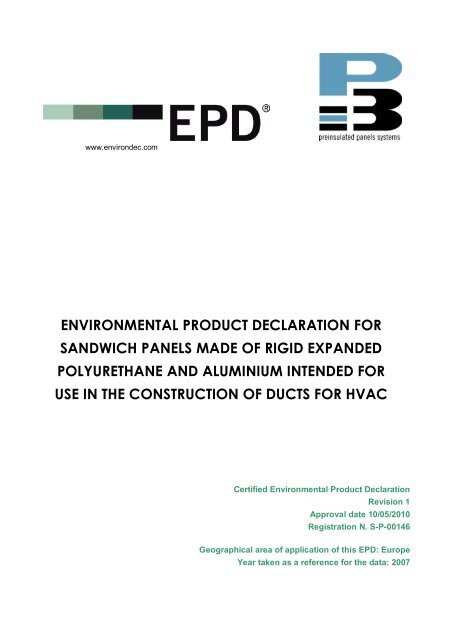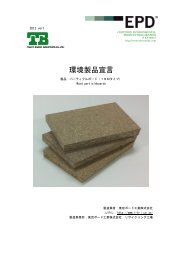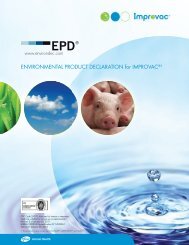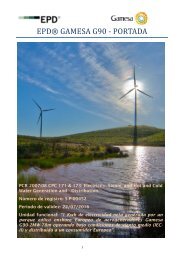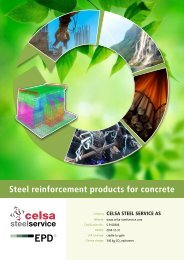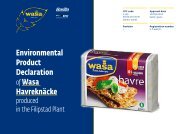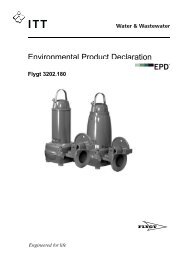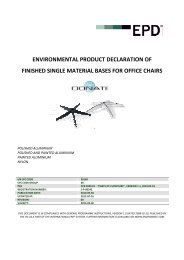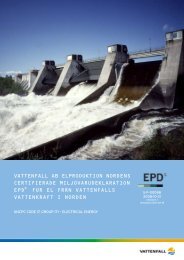EPD Euroball
EPD Euroball
EPD Euroball
- No tags were found...
You also want an ePaper? Increase the reach of your titles
YUMPU automatically turns print PDFs into web optimized ePapers that Google loves.
www.environdec.comENVIRONMENTAL PRODUCT DECLARATION FORSANDWICH PANELS MADE OF RIGID EXPANDEDPOLYURETHANE AND ALUMINIUM INTENDED FORUSE IN THE CONSTRUCTION OF DUCTS FOR HVACCertified Environmental Product DeclarationRevision 1Approval date 10/05/2010Registration N. S-P-00146Geographical area of application of this <strong>EPD</strong>: EuropeYear taken as a reference for the data: 2007
THE PIRAL HD HYDROTEC PANEL 15HP21The Piral HD Hydrotec panel 15HP21 is a sandwich panel, made up of an insulating core in rigidpolyurethane foam covered on both sides with an 80 μm sheet of embossed aluminium. This panelis particularly suitable for the construction of ductworks intended for use in HVAC.The thickness is 20.5 mm ± 0.5 mm. The rigid polyurethane foam is the result of a chemicalreaction between specifically formulated polyols and isocyanates and the expansion of the foam isachieved by using only water as blowing agent.The density of the PUR foam is 52 kg/m 3 , with a tolerance of ± 2 kg/m 3 .Thanks to the high content of closed cells (more than 95%), the foam in the panel shows an initialthermal conductivity λ i , as measured according to the standard ISO 8302, of 0,022 W/(mK) at amean temperature of 10 °C, which is equivalent to a thermal resistance R of 0,93 (m 2 K)/W. Thespecial sandwich structure makes it possible to achieve high mechanical performance, representedby a flexural rigidity of 200,000 Nmm 2 , declared according to the standards established by UNI EN13403.The use of aluminium for facings ensures a high level of hygiene and cleanliness, thus eliminatingthe problem related to the ageing of the insulating element and the release of particles. In addition,it guarantees the prevention of the proliferation of mould and bacteria. Indeed, as demonstrated bythe testing conducted according to UNI EN 13403 (paragraph 7.4 “Microbial growth”), no significantgrowth of microorganisms takes place in the area surrounding the inoculation.The panel may be used for the construction of ductworks within an air temperature range of -30 °Cand +65 °C operating on a continuous basis. The panel underwent different national andinternational tests aimed at assessing its features of reaction to fire and obtained, amongst others,the Class 0-1 reaction to fire according to the “Decreto Ministeriale del 26/06/84” and aclassification in class B-s3-d0 according to EN 13501-1 (SBI).Table 1 –Technical specifications of the panel for 1 m 2 ready for sale. Details are limited due to the degree ofconfidentiality of the specific formula.Material Quantity (net) UnitsOverall mass of the panel 1 1.526 kgEmbossed sheet aluminium 80 μm 100% primary 0.460 kgPolyurethane foam Piral HD Hydrotech formula 1.066 kgof which: Isocyanate + Polyol 0.904 kgFlame retardants, catalysts, dyes,surfactants0.149 kgWater 0.013 kg1 Excluding packaging and materials used for production processes only.3 of 13
DECLARATION OF ENVIRONMENTAL PERFORMANCEThis section includes the main features as well as the results of the assessment of theenvironmental aspects carried out on the basis of a life cycle using the LCA methodology.METHODOLOGYAs established by the “Requirements for the Environmental Product Declaration”, the quantificationof the environmental performance was worked out applying the methodology for Analysis of LifeCycle (LCA – Life Cycle Assessment) regulated by international standards ISO Series 14040 andin accordance with PCR 2008:06 Air ducts - substantial materials. The assessment methodologyLCA makes it possible to establish the degree of environmental impact caused by a product orservice in terms of the consumption of resources or in terms of the emissions in the environment,as well as the production of waste, as seen from a life cycle perspective (“from cradle to grave”, asit were).The data used, collected at P3, refer to the production of sandwich-type panels made of expandedpolyurethane/aluminium used for HVAC and especially to the Piral HD Hydrotec 15HP21 panel.Besides, the study also relied on the support of the database of Boustead Model 2 .The unit to which the results refer to (functional unit) is the production of 1 m 2 of panel.SYSTEM BOUNDARIES AND MAIN HYPOTHESESThe analysis considered the whole production system and was based on each single operationstarting from the raw materials production phase, including the production and transportation ofenergy vectors, to the intermediate and the final product transport.A preliminary outline of the considered system is illustrated in Figure 1, which shows three differentlevels related to specific production activities:1. the production of raw materials and their transformation, which took place in companiesproducing chemical or other materials (semi finished);2. the preparation of the mixture and the specific formulation on the site of P3, situated inRonchi di Villafranca;3. the production (in P3) and distribution of the product.2 www.boustead-consulting.co.uk4 of 13
UpstreamProcessesCore ProcessesEmissionsDownstreamProcessesPolyolsAdditivesIsocyanate (MDI)Poliols blendand specificmixture for theconsidered panel1 m2 panelproductionDeliveryUse PhaseEmbossedAluminiumAncillaryMaterialsProcessEnergyEnd of LifeWaste and scrapFigure 1 – Preliminary outline of the process considered. The yellow areas showthe operations carried out in P3. The dotted lines mark phases as viewed in qualitative way.As far as certain technical aspects are concerned, the following hypotheses may be underlined:the production system of materials used in the construction of the panel includes all thephases from obtaining the raw materials from the subsoil up to their production and use;the quantities of the above-mentioned materials are set in the product specifications whilethe energies involved in the process are quantified according to the overall volumeproduced;as for transport, the study considered the transport necessary for the stock-up of semifinished products and of consumption materials as well as the internal handling phases andfinal delivery;the activities carried out on the production site (heating, lighting, consumptionmaterials, etc.) are included within the system boundaries considering its overallproduction;delivery mode regards the transport of the product both in Italy and abroad. Theparameters considered for the distances covered are 1,000 km abroad, while in Italy theyare based on average distances within the three areas in which the country was divided forthis purpose: north, centre and south.Considering the fact that the process takes place entirely in the Italian territory, the data concerningenergy refer to the Italian energy mix, with the exclusion of the processes involved in themanufacture of some raw materials (isocyanate and polyols), in which case the European mix wastaken as a point of reference.5 of 13
With energy content [data in MJ]Without energy content[data in kg]ENVIRONMENTAL PERFORMANCEIn compliance with <strong>EPD</strong> ® system regulations, below is a table illustrating the environmentalperformance of the Piral HD Hydrotec 15HP21 panel showing details of the natural resourcesconsumption (with or without energy content) as well as the emission of pollutant substances andthe production of waste.Table 2 – Total consumption of resources related to the production of Piral HD Hydrotec 15HP21 panels. The data referto a unit of 1 m 2 of panel.Consumption of resourcesRenewableResourcesUpstreamProcessesCore ProcessesTOTALHydroelectric 10 0,4 10.4Wood and Biomass 1
Table 3 – Potential contribution to the main environmental effects of the production process of Piral HD Hydrotec15HP21 panels. The data refer to a unit of 1 m 2 of panel.IndicatorGlobal Warming Potential(GWP 100 )UnitsUpstreamProcessesCore ProcessesTOTALkg CO 2 eq. 11 1 12Acidification Potential (AP) mol H + eq. 3 0,5 3,5Eutrophication Potential(EP)Ozone Depletion Potential(ODP)Photochemical OzoneCreation Potential (POCP)g O 2 eq. 303 16 319g CFC11 eq. - - -g C 2 H 4 eq. 24.7 0.7 25.4Other significant data related to the description of the environmental impact of the system is theinformation connected with the production of waste. Table 4 shows the overall amount of wastegenerated by the production activities of Piral HD Hydrotec 15HP21 panels.Type of wasteTable 4 – Total of waste produced by the system. Data expressed in kg.UpstreamProcessesCore ProcessesTOTALOf which directlyproduced by P3Non hazardous 3.6 0.3 3.9 0.3Hazardous
USE PHASE AND END OF LIFEAs far as the use phase is concerned, the following considerations may be mentioned:Aluminium is not particularly degradable while polyurethane foam is non-putrescible,resistant to mould and stable from a dimensional point of view;The closed cells structure reduces remarkably the penetration of water, that within thespace of a few years may, both in its liquid form and as steam, originate degradationprocesses by hydrolysis;Like all the foams having closed cells, also this one is subject to "ageing" effect, by whichterm we mean a decrease in its insulating properties due to the process which tends toequilibrate the gas contained in the cells with the gas in the atmosphere.As for its disposal, it is possible to re-utilise the elements obtained from the ducts for insulationpurposes in the building construction (floor or wall cavities). For other parts, as an alternative, it ispossible to grind and separate (and possibly retrieve) the metal from the foam. Starting from thefoam, once this has been separated from facings, a chemical process may be applied (glycolysis)which makes it possible to obtain a liquid reactive product to be mixed with a new polyol. Anotherhypothetical procedure is that of mixing the powder obtained by fine grinding of the foam with thepolyol mixture intended for use in the production of insulating panels, at a proportional percentageof up to 10% by weight. As an alternative, on account of the high calorific power of the foam inspite of the flame retardants contained in it, the combustion process of the mixture with otherwaste, performed in special incinerators at very high temperatures makes it possible to “valorise”(waste-to-energy incineration) the "feedstock" energy available in the material.Finally, sending the waste to the landfill after the grinding and compacting processes have beencompleted, should be seen as the last solution.Since the performance in terms of thermal insulation ensured by Piral HD Hydrotec 15HP21 panelsis strategic in evaluating the saving in energy related to the choice of preinsulated ducts, it wasdesired to go deeper into that aspect by examining the performances derived from the applicationof different types of technologies to a standard HVAC model.For the sake of concreteness, below is an example of calculation used for a theoretical evaluationof the energy consumption associated with a standard HVAC model. Below are the data related tothe project:HVAC system with a surface of 500 m 2 of ducts capable of supplying 8500 - 9000 m 3 /h oftreated air in a block of offices of about 600 – 650 m 2 ;Ductworks made of preinsulated panels Piral HD Hydrotec 15HP21, λ u 5 = 0.024 W/(m K)(evaluated at a mean temperature of 10 °C) installed on a double ceiling or, as usual, not inthe same room where the treated air is distributed;5 The value for thermal conductivity mentioned refers to a value of λu used in the project, i.e. a value declared by the manufacturerwhich may be used by the designer for calculation purposes. This figure is also attributable to the same property during a period oftime regarded as economically reasonable in normal conditions allowing for any possible ageing or statistical corrections.8 of 13
Operation of the system in summer: cooling of the workplace, estimated for an averagetime of 10 hours a day, for 5 days a week and for a total of 4 months (an overall total of 850hours);The difference in temperature between internal air (about 17 °C) and external air (about 32°C) is equivalent to 15°C.Considering that the above value for thermal conductivity refers to a mean temperature of 10 °C, inorder to calculate the actual performance of the ducts system in terms of energy it will benecessary to consider the value of λ u at a mean working temperature of 25 °C. To calculate thisconversion (Table 5) we must use the rules listed in EN ISO 10456 – 2007 (Building materials andproducts – Hygrothermal properties – Tabulated design values and procedures for determiningdeclared and design thermal values):λ 2 = λ 1 * F twhere Ft is the correctional factor for the working temperature, while the starting value for thermalconductivity is the figure declared by the manufacturer at 10 °C.F t = exp[f T *(T2-T1)]with f T being equivalent to the conversion coefficient for the fixed temperature established by thestandard EN ISO 10456, which is 0.0055 for polyurethane foams with a thermal conductivity valueof up to 0.025 W/(mK).Table 5 – conversion of the values for thermal conductivitySolution λ 1 [W/(m K)] f T [1/K] T2-T1 [K] F t λ 2 [(W/(mK)]Polyurethane 0.024 0.0055 15 1.086 0.0261The energy consumption was worked out through an evaluation of the thermal power Q d (kW) lostthrough the walls of the HVAC system by applying the following formula:Q d = U * ΔT * Swhere U is the thermal transmittance of the ducts’ walls, ΔT the difference in temperature betweenexternal and internal air and S the total surface of the ducts system. Table 6 shows the abovementionedcalculations:9 of 13
Table 6 – physical/thermal evaluation of energy dispersion in the standard modelUnits Piral HD Hydrotec 15HP21 panelThickness m 0.0205 (insulating material 0.020)Thermal conductivity λ u W/(m K) 0.0261Resist. of insulating material (m 2 K)/W 0.766Internal liminar resist. (m 2 K)/W 0.043External liminar resist. (m 2 K)/W 0.0122Total resistance (m 2 K)/W 0.93Thermal transmittance U W/(m 2 K) 1.07ΔT K 15Lost thermal power Q d kW 8.05Having hypothesised an operating time of 850 hours, the amount of thermal energy lost is about6845 kWh which, expressed in a different unit of measure, is equivalent to 24642 MJ.ADDITIONAL INFORMATION AND REFERENCESThis section of the declaration includes additional information connected with companymanagement and with the validation procedure of the document.TECHNICAL PERFORMANCE OF THE PRODUCTTo complete the description of the product being analysed, here is a brief illustration of otherfeatures offered by the Piral HD Hydrotec 15HP21 panel:Low weight: the extreme lightness of the panel makes it possible to reduce the weight ofthe load supported by the bearing structures, by the bracketing points and to reduce thelabour force and the amount of materials needed for the final installation of the duct;Low noise level: the sandwich-type structure of the panel (aluminium-insulating materialaluminium)guarantees good acoustical behaviour;Durability: the external aluminium sheets coupled with the insulating material impartsturdiness, rigidity and good resistance to corrosion, to erosion and to deformation, evenwhen the panel is used in particular applications;Safety: the Piral HD Hydrotec 15HP21 panel shows a limited degree of participation incase of fire accidents, it does not drip and the fumes produced have low degrees of opacityand toxicity, thus meeting the criteria established by the most stringent internationalstandards.ENVIRONMENTAL PHILOSOPHY OF THE COMPANYSince the year 1996 P3 has operated according to the UNI EN ISO 9001-2000 standards, and laterachieved the environmental certification UNI EN ISO 14001-2004 and OHSAS 18001-99. Forbroader diffusion of the outstanding environmental performance of its products, P3 has publishedthis environmental product declaration with the format of an <strong>EPD</strong>.10 of 13
Among the actions aimed at perfecting its efforts in environmental matters, P3 would like tomention the following:increase in the stock-up of raw materials in re-usable 1000 kgindicator small tanks, thusreducing the number of metal containers (drums) used and the scrap produced;introduction of a coefficient to express the waste/m 2 ratio of produced panels. This makes itpossible to evaluate this parameter and to decide what actions should be taken in order toimprove on it;constant monitoring of the panels’ density in order to identify sensitive parameters and thusimprove productivity while still using the same raw materials for production;sensitising the supplier of aluminium sheets to the possibility of using alloys, which may beobtained from recycled material and offer the same level of performance;reduction in energy consumption, by enacting a policy aimed at minimising waste (e.g.turning the PC off during the lunch break or while not in use, lowering the heatingtemperature by 2 °C during the winter season, etc.).CONTRIBUTION OF GENERIC DATAThe employment in this study of generic data characterised only the production of the mixture forthe construction of the panel. When verification took place, it was calculated that the influence ofgeneric data is inferior to 10%.11 of 13
CONTACTSFor further information about the activities undertaken by P3 or about this environmentaldeclaration, please contact Mr Nicola Mela, Tel. 0499070301, e-mail n.mela @p3italy.it.As an alternative, you may visit our site http://www.p3italy.it/.Technical support was offered to P3 by the Study Life Cycle Engineering in Turin (www.studiolce.it- info@studiolce.it).REFERENCESGeneral Programme Instructions for <strong>EPD</strong> and Supporting AnnexesPCR 2008:06Analysis of production operations for panels made of expanded polyurethane using themethodology known as Life Cycle Assessment (LCA), Final Report 8 October 2008 (LifeCycle Engineering, www.studiolce.it).Technical data sheets P3 (http://www.p3italy.it/)Boustead Model database and databases according to PCRINFORMATION ABOUT THE CERTIFYING BODY AND ABOUT THE PCRPCR 2008:06 review, was conducted by:P3 - Life Cycle EngineeringIndependent verification of the declaration and data, according to ISO 14025:□ Internalx externalThird party verifier:RINA Services S.p.A. Certification Body (www.rina.org) accredited by SWEDAC(registration n° 1812) and ACCREDIA (registration n° 001H).Valid until: 26/11/2011Please note that <strong>EPD</strong>s obtained with different programs may not be comparableGLOSSARYCategories of environmental impact taken into consideration:· Acidification Potential(AP): phenomenon by which atmospheric rainfall has a pH which is lower than average. Thismay cause damage in forests and cultivated fields, as well as in water ecosystems and objects in general. Thisphenomenon is due to the emissions of SO 2, of NO x, and NH 3, which are included in the Acidification Potential (AP)index expressed in masses of H + produced.· Ozone Depletion Potential (ODP): degradation and depletion of the ozone layer in the stratosphere, which has theproperty of blocking the ultraviolet components of sunlight thanks to its particularly reactive compounds, originatedby chlorofluorocarbons (CFC) or by chlorofluoromethanes (CFM). The substance used as a point of reference forassessing the ODP (Ozone Depletion Potential) is trichlorofluoromethane, or CFC-11.· Global Warming Potential (GWP): phenomenon by which the infrared rays emitted by the earth’s surface areabsorbed by the molecules in the atmosphere as a result of solar warming and then re-emitted in the form of heat,thus giving rise to a process of global warming of the atmosphere. The indicator used for this purpose is GWP12 of 13
(Global Warming Potential). This mainly includes the emissions of carbon dioxide, the main greenhouse gas, as wellas other gases with a lower degree of absorption of infrared rays, such as methane (CH 4), nitrogen protoxide (N 2O),chlorofluorocarbons (CFC), which are expressed according to the degree of absorption of CO 2 (g CO 2 ).· Eutrophication Potential (EP): enrichment of the watercourses by the addition of nutrients. This causes imbalance inwater ecosystems due to the overdevelopment encouraged by the excessive presence of nourishing substances. Inparticular, the Eutrophication Potential (EP) includes phosphorous and nitrogen salts and it is expressed in grams ofoxygen (g O 2).· Photochemical Ozone Creation Potential (POCP): production of compounds which by the action of light are capableof encouraging an oxidising reaction leading to the production of ozone in the troposphere. The indicator POCP(Photochemical Ozone Creation Potential) includes especially VOC (volatile organic compounds) and is expressedin grams of ethylene (g C 2H 4).· Cumulated energy (Gross Energy Requirements - GER): is the overall amount of energy involved in a productionsystem. This is made up of the addition of all the quantities of energy inherent in all the operations from theextraction of raw material. Gross energy may be subdivided at least in five categories: direct energy or energycontent of fuel, feedstock energy, production & delivery energy, transport energy and biomass energy.13 of 13


